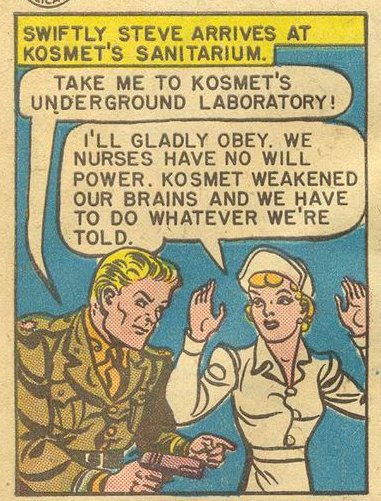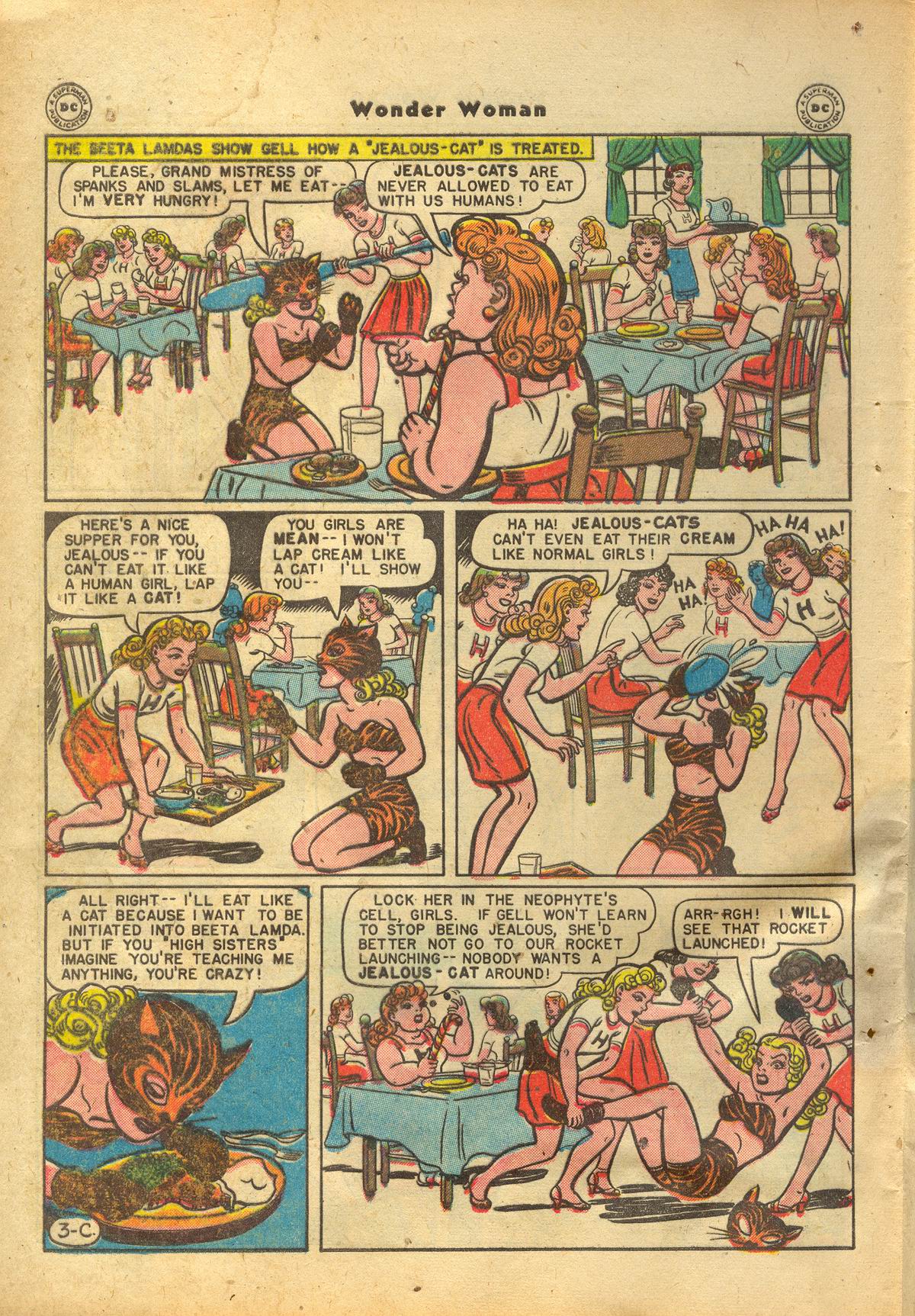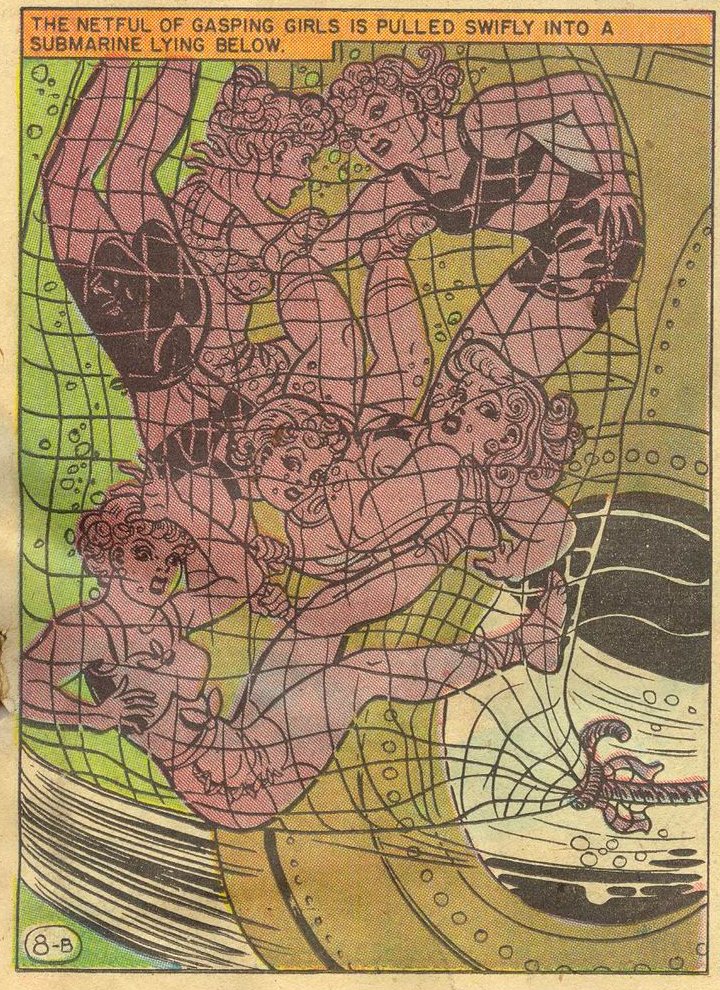As I said in our last installment, Wonder Woman #21 was great. Marston died in May 1947, but you’d never know he was on his deathbed when #21 came out in January/February of that year. One of the high points of the series, it shows Marston enthusiastically grappling with and even more enthusiastically fetishizing the latest, most up-to-date technology of atomic power. Most people would stop adding kinks to their repertoire when they were dying, but Marston is not the sort to let a little thing like cancer get his libido down. It’s an inspiration to us all, I tell you.
But that was 21. In #22, things are…well, they’re not so great. In fact, I strongly suspect that the very, very ill Marston did not have complete creative control over this issue. Marston had sometimes worked with collaborators before, I think — his sons were supposed to have given him story ideas at least — and certainly he’s had less than stellar issues before. But this is the first one that actually starts to look in spots like hackwork.
Among other problems, this is the first issue since the second or third that isn’t a single long story; instead, it’s split up into three shorter tales. The initial one of these is definitely the worst; I’d wager something of moderate value that somebody ghosted large chunks of it. Wonder Woman goes to Hollywood, where a evil mastermind is stealing the color from the faces of actresses and then forcing them to pay to have their color restored. So basically, instead of Wonder Woman saving the world, she’s helping a handful of vain actors deal with cosmetic surgery. The low stakes and the stereotypical focus on appearance is a painful forshadowing of the crappy Silver Age Robert Kanigher scripts to come…and just to drive that point home there’s a completely pointless sequence where WW is taken by the police and thrown in prison, a typical Silver Age twist which here (as in the future) serves to generate some vague suspense in a plot that is basically going nowhere. Towards the second half of the story things start to come alive a little as the Holiday girls and then Wonder Woman are tied up and the evil scientist reveals that he has a brain control ray which he uses to make a bunch of nurses his slaves (not sure I’ve seen the nurse fetish from Marston before?).
And of course WW is almost placed in his thrall too, but Steve comes in in the nick of time and rescues her…and again, having Steve as the deux ex machina just is not Marston in prime form.
The second and third stories are somewhat better — or at least more characteristic. Number two involves the Saturnians again (remember them from way back in issue 10?) They use hypnotism to prevent people from seeing them, and there’s some sort of electrical bonds which makes WW all weak and kitteny and then they can tie her up. Not really covering any new ground, but it’s okay for that.
Three has the most potential; one of the Holiday sorority girls, Gel, is jealous…and her jealousy almost destroys the planet Venus! Before it does, though, she’s punished by…well see for yourself:
That’s the stuff! The jealousy theme is pretty interesting too; it’s come up before in Marston, specifically in #6 in the battle with the Cheetah. In some ways this is actually more successful. In #6, the Cheetah’s resentment of the stuck-up Amazons and their compulsive condescension seemed a lot more sympathetic than I think Marston wanted, whereas in this one, Gel’s jealousy of her fellow students seems pettier and less rationally motivated. (Not that Gel isn’t somewhat sympathetic too.)
It’s also interesting to think about why jealousy seems important to Marston. In my post about the Cheetah, I said that it seemed to be about self-esteem — that is, woman should feel good about themselves and not inferior to anyone. But I also wonder if there’s a sense in which Marston finds jealousy especially problematic because it’s a primary source of conflict between women. Or to look at it another way; the flip side of female-female friendships or female-female desire can be jealousy — wanting to be somebody else instead of wanting to be with them (as friends or…well, you know.) On the one hand, then, jealousy is the acid that dissolves the bonds of sisterly love. On the other hand, it’s a kind of extension of that love twisted into desire. Which means that, for Marston, jealousy is exciting and fetishized — which is why jealous Gel gets placed so quickly in the cat suit. Her punishment is stimulating, but so is her rebellion.
Though not as stimulating as they might be alas. The splash page to this story promises that Gel will bring jealousy to Venus, and I had visions of her somehow spreading jealousy throughout the perfect Venusian society through some sort of ray or serum or other weirdness — which sounded pretty great. But in the end she just shows up and frees some prisoners and causes a garden variety ruckus…and then it all resolves in two really fast pages, as if everyone just ran out of script. Which is maybe what happened; Marston may just have gotten too sick to finish the thing (or they could be using an earlier ms that he abandoned or never completed.)
Along those lines, perhaps the most interesting or revealing thing about this issue is that the art isn’t very good. Not that it’s terrible; Peter still has some nice set pieces, like this weird and funny undersea clump of Holiday girls:
But in general, compared to much of the remarkably adventurous art in this run, this issue is both tame and bland. The layouts are fairly boring, and Peter makes little effort to unify pages visually (using colors, shapes, or themes as he does in many other issues.) The wordless sequences which the duo have been experimenting with are also abandoned. Costuming is less detailed, and layout and rendering are all less imaginative throughout. Peter is still Peter, and the art is still fun to look at, but he seems to have lost much of the visual spark that pushed him from being a very good illustrator to (in my mind) one of the all time greats.
So what was that visual spark? I can’t know for sure, obviously, but I really wonder if it wasn’t Marston. I’ve noted before that when Marston’s scripts aren’t so great, the art also seems to falter. Here I’m pretty sure that Marston was side-lined — and sure enough, the art suffers badly. Which makes you wonder…was it Marston who was specifying those wordless sequences? Was he involved closely in layout? How specific were his scripts?
I suppose it’s possible that Peter was just more inspired when he had good material. But the fact that so much of his more interesting stylistic choices disappear here where Marston seems out of the loop — it just makes me think that Marston (who, as I’ve mentioned before, actually hired and paid Peter himself) may have had substantial direct input into the art. How I would love to get my hands on one of his scripts….
__________________
So…there are in theory 6 more Marston/Peter WW issues left. I know that #28 is very good…but now I’m more than a little worried that the next five are going to be a slog. Marston was supposed to have been writing scripts on his death bed, so it’s possible that he generated some more first class material. We’ll see, I suppose….





I wonder if there is a Marston archive somewhere that has copies of his scripts.
I don’t know. I presume Les Daniels would have done some of that research; his book seems fairly thorough, and there’s no discussion of scripts…
Here’s an article from Alter Ego v.3 #2 by Roy Thomas that discusses seeing a script and mentions a previously article that printed a script (v.3 #1) (if I’m reading that correctly):
http://twomorrows.com/index.php?main_page=page&id=23
And this page seems to indicate the original article had a couple pages of the second script included as an image.
Ahh… On Google Books:
http://books.google.com/books?id=rFm0hok1c8sC&lpg=PP1&pg=PA67#v=onepage&q=wonder%20woman&f=false
Never challenge a librarian, is the lesson here.
That’s pretty interesting. No notes about page layout…but, on the other hand, the pages shown are pretty straightforward. Still, it’s certainly not evidence for my suspicion that Marston was seriously engaged with creating the art….
If you read Marston’s descriptions of the contents of the panel and compare them to the page they show, you can see how Peter wasn’t exactly following Marston’s suggestion. For instance page 2 panel 8 is a pretty straightforward image of WW and some big dude. Mostly head and shoulders. On the other hand, Marston’s description has a guy with his knees in WW’s back as he ties her up. I guess Peter wasn’t as in to the bondage as Marston.
Who was?
I’ll have to look at it more closely this evening maybe….
I wonder if Peter was simply suffering from artistic burnout. He’d been working on Wonder Woman for several years by this point … maybe he was just bored with the comic, and working on WW was no longer a creative activity at all but simply a job.
Which isn’t to say there’s no correlation between Marston’s illness and the decline in the art. But perhaps it has less to do with Marston’s direct artistic input than with Peter just feeling less inspired without Marston’s kooky ideas to work with.
“Who was?”
Who was what?
“I guess Peter wasn’t as in to the bondage as Marston.”
“Who was?”
I’m still baffled.
I’m saying nobody was as into bondage as Marston. Damn it.
Oh, I was reading the inflection on that. I was reading it like an actual question. D’oh.
I WASN’T reading the…
Noah,
First off, love the blog. Second, some info and thoughts. I found this “Eventually, Dr. Marston would have even bigger problems to worry about. Around the time World War II came to an end Marston was diagnosed with polio, the disease that apparently, by law, every historical figure of the 20th Century must have at some point in their lives. The last few years of his life would have him bound, in a way; but to a wheel chair. In spite of his physical limitations, he would still dedicate everything he had left to telling Wonder Woman stories even if he had to get help.
Another woman then entered his life. The man had vagina falling out of his pockets, but no, this wasn’t a sex thing, she would be his secretary-writer. By 1945, Marston was too ill to write his stories himself. He would perform the story out from his bed as Joyce wrote them down. By 1947, Marston’s health declined even farther as he was diagnosed with lung cancer. And even then, he was writing up until the last week of his life. Just two days before his death, he was going over pencil proofs and editing mistakes. William Moulton Marston died on May 2, 1947. His final story was a book-length epic titled “Villainy Incorporated”. Marston, unrepentant to the bitter end, called for no less than seventy-five panels of girls getting bound. The final words of his last issue was spoken by Wonder Woman’s mother, “The only real happiness for anybody is to be found in obedience to loving authority.” at
http://geekscape.net/history-of-the-nerd-part-i-3-the-creator-of-wonder-woman-a-portrait-of-a-bondage-fetishist.htm
Bearing in mind he was sick and his wife was helping him, the thought of a woman losing her face, i.e. her identity makes sense if your husband has a second wife. Also the jealousy story makes sense if you’re the patriarch of an “unconventional” family. Looking up Martson on the Web I ended up at a pro-polyamory site and the dangers of jealously was prominantly featured. This was about Marston’s life. Plus he wasn’t even being subtle. Those cat sorority pictures, wow.
Marston strikes me as the kind of guy “who tops from the bottom.” He may have liked being tied up, but he was still in charge.
Or I could be wrong, I’m must trying to sound smart.
Hey Jim. I’d forgotten about his polio! The jealousy angle being tied into polyamory is interesting. Marston doesn’t usually have it being jealousy over a man, though…and his wife and girlfriend were almost certainly lovers themselves, which maybe inflects things slightly differently. Still, it’s a good point.